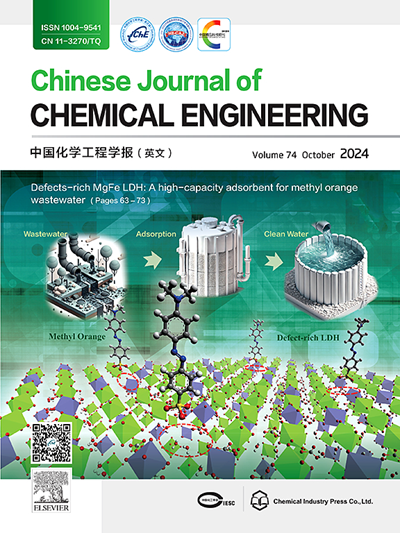Molecular insights into the fast hydrate formation in active ice
IF 3.7
3区 工程技术
Q2 ENGINEERING, CHEMICAL
引用次数: 0
Abstract
Molecular dynamics simulations were performed to study the microscopic working mechanism of fast hydrate formation from active ice. We successfully simulated the cyclic process of ice melt-hydrate formation-ice melt. The simulation results showed that active ice could significantly accelerate the formation of hydrates and exhibit high gas storage capacity. The oxygen atoms of the sulfate group in SDS formed hydrogen bonds with the hydrogen atoms of water molecules in the ice, destroying the orderly arranged structures of the ice surface. SDS also acted as a promoter to accelerate the mass transfer of guests in the liquid phase, thereby promoting the nucleation and growth of hydrates. The ordered structures of liquid phase formed by ice melting and the formation of cage-like structures facilitated by ice surface defects were beneficial to the nucleation and growth of hydrates. The formation of the hydrate shell accelerated the migration of the guests from the gas phase to the liquid phase. As the ice continued to melt, sufficient guests and water molecules ensured the stable growth of hydrates.
活性冰中快速水合物形成的分子洞察
通过分子动力学模拟研究了活性冰快速生成水合物的微观工作机理。我们成功地模拟了冰融化-水合物形成-冰融化的循环过程。模拟结果表明,活性冰能显著加速水合物的形成,具有较高的储气能力。SDS中硫酸盐基团的氧原子与冰中水分子的氢原子形成氢键,破坏了冰表面有序排列的结构。SDS还起到促进剂的作用,加速液相中客体的传质,从而促进水合物的成核和生长。冰融化形成的有序液相结构和冰表面缺陷促进笼状结构的形成有利于水合物的成核和生长。水合物壳的形成加速了客体从气相向液相的迁移。随着冰的不断融化,足够的访客和水分子保证了水合物的稳定增长。
本文章由计算机程序翻译,如有差异,请以英文原文为准。
求助全文
约1分钟内获得全文
求助全文
来源期刊

Chinese Journal of Chemical Engineering
工程技术-工程:化工
CiteScore
6.60
自引率
5.30%
发文量
4309
审稿时长
31 days
期刊介绍:
The Chinese Journal of Chemical Engineering (Monthly, started in 1982) is the official journal of the Chemical Industry and Engineering Society of China and published by the Chemical Industry Press Co. Ltd. The aim of the journal is to develop the international exchange of scientific and technical information in the field of chemical engineering. It publishes original research papers that cover the major advancements and achievements in chemical engineering in China as well as some articles from overseas contributors.
The topics of journal include chemical engineering, chemical technology, biochemical engineering, energy and environmental engineering and other relevant fields. Papers are published on the basis of their relevance to theoretical research, practical application or potential uses in the industry as Research Papers, Communications, Reviews and Perspectives. Prominent domestic and overseas chemical experts and scholars have been invited to form an International Advisory Board and the Editorial Committee. It enjoys recognition among Chinese academia and industry as a reliable source of information of what is going on in chemical engineering research, both domestic and abroad.
 求助内容:
求助内容: 应助结果提醒方式:
应助结果提醒方式:


